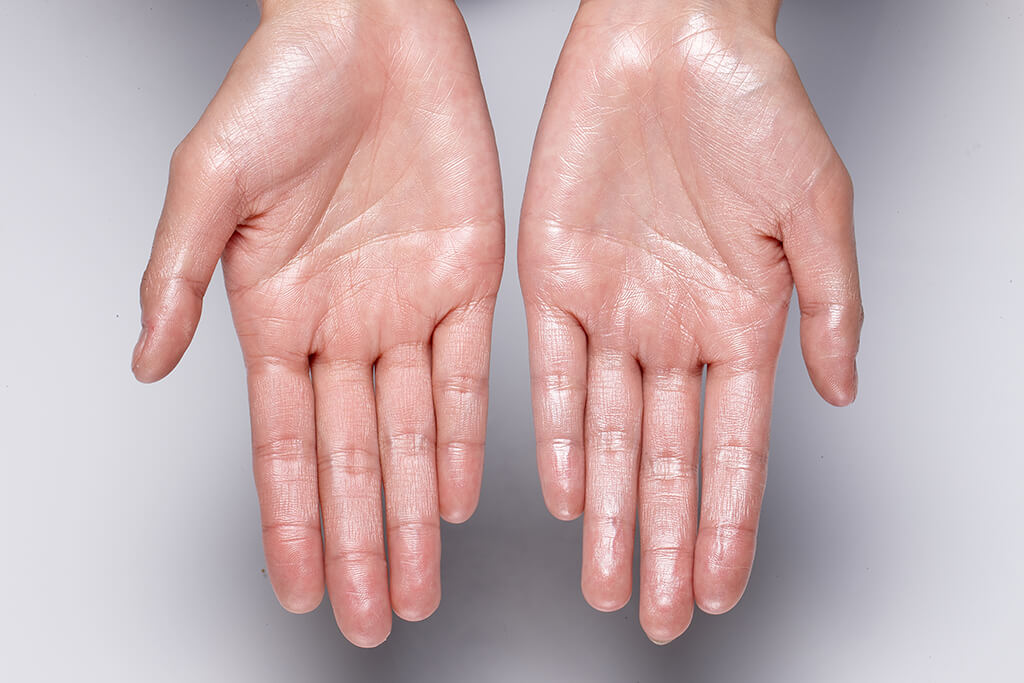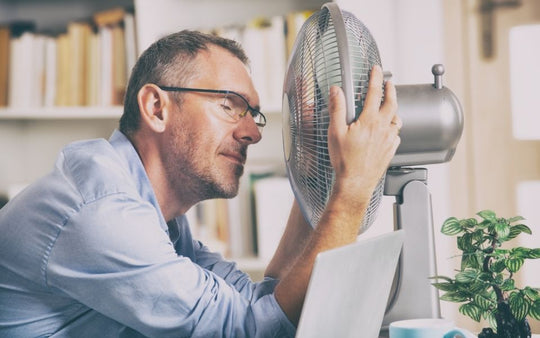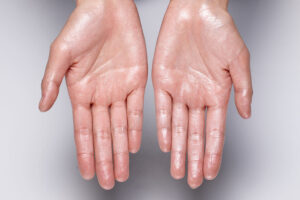Table of Contents
If you suffer from hyperhidrosis (also known as excessive sweating), you’ve likely heard of Iontophoresis. This unique hyperhidrosis treatment can be very effective in reducing the symptoms of hyperhidrosis.
We won’t lie, iontophoresis is a bit odd. For this reason, we’ve made a list of the most common questions about iontophoresis. Hopefully the answers will help you in your quest to stop unwanted sweat.
Iontophoresis: Frequently Asked Questions
1. What is iontophoresis? Who invented it and when?
2. How does iontophoresis therapy work?
3. Does iontophoresis work for hyperhidrosis?
4. How often should I have treatments?
5. When will iontophoresis start working?
6. What areas of the body can be treated with iontophoresis?
7. Can iontophoresis work on my underarms?
8. What is an iontophoresis patch and how does it work?
9. Does iontophoresis hurt?
10. Can I be electrically shocked by iontophoresis?
11. Is the iontophoresis treatment permanent?
12. Are there side effects from iontophoresis?
13. Who performs iontophoresis?
14. Will my insurance pay for iontophoresis?
15. How much do iontophoresis treatments cost?
16. What is the best iontophoresis machine for me?
17. How much will an iontophoresis machine cost and where can I buy one?
18. What if I’m pregnant? (and other iontophoresis contraindications)
19. What other hyperhidrosis treatments can I try?
1. What is iontophoresis? Who invented it and when?
Iontophoresis is a medical procedure which uses a mild electrical current to gently push medications through the skin while the treated body area is submerged in water. You might think of it as an injection without a needle.
The procedure is most often used to treat hyperhidrosis or uncontrolled, profuse sweating. It can also be used to treat injuries related to sports by delivering anti-inflammatory medicines directly through the skin.
The idea of using weak electrical energy to deliver medicine dates back to the mid-18th century. Significant progress was made by several researchers in the 19th century and the concept gained serious traction soon after.
In the early 1900’s, Dr. Stéphan Leducafter, a French physician, published a series of scientific papers on the subject. Other contributors to the science were Benjamin Ward Richardson, Hermann Munk, William James Morton, and Fritz Frankenhäuser.
Recently, researchers have given iontophoresis a fancy new name: “electrically-assisted transdermal drug delivery.” This is what too many years of education can do. 😉
2. How does iontophoresis therapy work?
Iontophoresis works on the principle of ions. In this instance, the ions are water-soluble substances that carry either a positive or negative charge. Like the poles of a magnet, the positive electrode repels and the negative electrode attracts.
By running a mild galvanic (direct) current through a shallow container of water, an ion can be pushed into the skin if the active electrode has the same charge as the target ion.
The principle is the same as when two positive ends of a magnet push away from each other when they are placed together.
Because the skin is an excellent barrier and protects the body from outside intrusion, iontophoresis has limited value in delivering medications directly into the skin.
Generally speaking, a patient receiving iontophoresis treatment for hyperhidrosis sits with one or both hands or feet immersed in a shallow pan or tray filled with tap water.
Normally anticholinergic medicines are placed in the water that block the transmission of nerve signals to the sweat glands. By stimulating the iontophoresis electrodes, the electrical current “pushes” the medication into the skin. Treatments can last from 15 to 40 minutes.
3. Does iontophoresis work for hyperhidrosis?
The short answer is yes. While iontophoresis has limited usefulness in treating other conditions, it can be effective in treating certain types of primary or focal hyperhidrosis.
The procedure is routinely used for the treatment of palmar hyperhidrosis (excessive sweating of the hands) and plantar hyperhidrosis (excessive sweating of the feet).
4. How often should I have treatments?
Always consult with your doctor before beginning a regimen of iontophoresis treatments. Usually, the process is repeated 3 times a week in the beginning, and until sweating is reduced to the desired degree. Then patients are switched to a schedule of one treatment each week.
To maintain effectiveness, treatments must be consistent and performed regularly before your sweating begins to return.
5. When will iontophoresis start working?
Patience is a virtue. That may not be a comforting thought as you deal with excessive, unrelenting sweating, but it’s important to keep in mind. How long it takes to see results varies significantly from person to person.
Some patients report positive results in the first day of treatment. For others, it may require three to four weeks of consistent treatment before the sweating is significantly reduced.
Most patients see a discernable difference by the end of the first week. If it’s going to work for you, that’s the benchmark to keep in mind. Long-term improvement is usually achieved after a few weeks of regular treatments.
6. What areas of the body can be treated with iontophoresis?
Iontophoresis has been used to treat hyperhidrosis since the 1940’s. Most medical studies have focused on the procedure for hyperhidrosis of the feet (plantar) and the hands (palmar). Fewer studies have examined hyperhidrosis of the armpits (axillary).
In one year-long study of 27 patients with palmoplantar hyperhidrosis (affecting the hands and feet), there was a “good” response. Desired improvement took from 2 to 4 weeks.
In every successful case, ongoing treatment was necessary to maintain dryness. When used correctly, iontophoresis can have a positive effect on 85% to 90% of hyperhidrosis patients.
7. Can iontophoresis work on my underarms?
The evidence collected so far shows that iontophoresis of the underarms might be an effective option for some people. The International Hyperhidrosis Society notes that iontophoresis is generally less effective than other methods for managing underarm sweating.
A clinical strength antiperspirant may be more effective in treating excessive underarm sweating.
8. What is an iontophoresis patch and how does it work?
An iontophoresis patch is an electrodynamic patch made from fabric material mingled with photovoltaic cells. Micro-currents are created by the transdermal patch when it comes in contact with the skin.
These currents use the iontophoresis principle to suppress the sweat glands from secreting sweat. Iontophoretic patches can be used on hands and feet, but are especially suited for underarm iontophoresis treatments.
A pouch containing a dosage of medication can be attached to an iontophoresis patch which delivers the medication directly through the skin.
Iontophoresis dexamethasone is a cortisone-like medication that is often used in conjunction with this treatment. It can provide relief from inflammation and helps prevent unwanted side effects.
Sometimes a Diclofenac gel is applied topically to reduce the inflammation.
The ActivaPatch is a self-contained single-use drug delivery patch that contains an electrical source (a battery), electrode and chamber into which desired medicines can be placed.
Once adhered to the skin in the desired location, it can provide up to 2.5 hours of iontophoresis treatment.
9. Does iontophoresis hurt?
No, iontophoresis treatments are not known to cause pain. But at the same time, it’s not what you would call “pleasant” either. When performed correctly, the treatment is rarely painful, though many patients report feeling mildly uncomfortable.
You will likely experience a tingling sensation during the process. Be sure you don’t have any open sores or wounds in the area to be treated.
The sensation will be much stronger if the current passes through open skin. You can cover any open skin with petroleum jelly to protect it.
10. Can I be electrically shocked by iontophoresis?
You can’t be seriously electrically shocked, but you may feel surprised by the tingling. The voltage of the electrical current used in iontophoresis is low and not strong enough to cause a harmful shock.
But if it’s not done correctly, or if you remove your hands or feet from the water during treatment– or if equipment malfunctions– the sensation might be a trifle unexpected.
You may temporarily experience minor heel pain during an improper foot treatment, for example. Be sure to remove any metal jewelry beforehand.
As the electrical current is increased, any unpleasant sensation will increase. But you’ll be in control and you’ll be able to decrease the current if the treatment becomes too uncomfortable.
It’s a good idea to have another person present during treatments. If you’re using an iontophoresis machine at home, be sure to completely read the manufacturer’s user guide and follow all suggested instructions and precautions.
11. Is the iontophoresis treatment permanent?
No, iontophoresis for hyperhidrosis is not a permanent solution. After the initial treatment period when the desired level of sweat reduction is achieved, maintenance treatments must be continued indefinitely (usually once a week).
It is important not to wait until the excessive sweating returns. Permanent hyperhidrosis treatments require more invasive treatments or surgical options.
12. Are there side effects from iontophoresis?
While iontophoresis is a safe and relatively pain-free treatment, some patients may experience some minor adverse effects. The good news is that any side effects are easily alleviated and generally not serious. The most common side effect is itching and drying of the skin.
Apply a moisturizing cream or lotion after each treatment to hydrate and soothe dry skin. Other possible side effects include blistering, skin irritation and peeling.
13. Who performs iontophoresis?
Many primary care or family practice doctors can administer the iontophoresis treatments. Some neurologists, internists, and surgeons will also offer the treatment. Seeking out a dermatologist will probably be your best bet.
After initial treatments performed by a qualified physician, it is not uncommon for patients to continue treatments at home with equipment that can be purchased for personal use.
14. Will my insurance pay for iontophoresis?
That depends on your insurance carrier. Sadly, iontophoresis for hyperhidrosis is a treatment that some insurance carriers consider unproven or investigational.
If that’s the case for you, you’ll have to pay out-of-pocket. Some physicians will allow you to negotiate the cost of treatment if your insurance will not cover it.
15. How much do iontophoresis treatments cost?
Iontophoresis treatments in a doctor’s office will set you back about $150 to $200 per session. Costs can vary significantly depending on the selected practitioner and location. It’s going to cost you more in Los Angeles than in Fargo, North Dakota.
If you decide to administer the treatments yourself after your initial doctor visits, you can purchase your own equipment. When you consider the cost of several treatments at the doctor’s office, this investment can be a cost-saving alternative.
16. What is the best iontophoresis machine for me?
The best machine for your specific condition depends on a lot of variables. Be aware that the manufacturer of any iontophoresis device is going to claim that their machine is the best. Here are important factors to consider when looking to purchase an iontophoresis machine for home use:
- Affordability – Find a device that works within your budget. You’ll find many that will work.
- Machine size – If the machine will be used at home, size may not be an issue. If you travel a lot, you’ll want something you can pack and take with you.
- Safety – Find a machine that has safety features that eliminate the possibility of electrical shock.
- Timers – The duration of treatments is critical to potential success. An onboard timer will be helpful in making sure treatments aren’t too short or too long.
- Power source – Some machines are battery powered only. Replacing those batteries can be expensive.
- Warranty and Service – Choose a machine that includes a warranty (at least 12 months) and be sure the manufacturer offers a user-friendly customer service program.
17. How much will an iontophoresis machine cost and where can I buy one?
A quality iontophoresis machine with basic features should cost somewhere between $500 – $700. If your budget won’t allow for an investment of several hundred dollars, there are low-cost machines available online starting at about $100.
Be cautious of low-priced machines, as safety features and build quality may have not been high on the maker’s priority list. Do your research. There are many choices available online, and they can also be purchased from local medical supply brick-and-mortar stores.
Also, if you’re handy, it’s fairly simple and easy to build one of your own.
18. What if I’m pregnant? (and other iontophoresis contraindications)
Always consult a doctor before commencing iontophoresis treatments. There are several conditions and situations for which either extra caution or total avoidance of the treatment are necessary.
- If you wear a pacemaker – The electrical current used in iontophoresis, although mild, may interfere with a pacemaker.
- Pregnancy – Iontophoresis has not been tested on pregnant women. If you’re pregnant, iontophoresis treatments are not recommended.
- Metal orthopedic implants – Because electrical current will pass through the parts of the body being treated, any metal implants in those areas can cause problems. Talk to your physician about the treatment if you have any metal implants in your body.
- Cardiac arrhythmia – Electrical impulses trigger your heart to beat. If you have an irregular heart condition, you should avoid iontophoresis unless your doctor specifically recommends it and supervises the treatment.
- Skin rash or disease – Iontophoresis therapy should be avoided if a skin rash or skin disease is present in the affected areas.
19. What other hyperhidrosis treatments can I try?
Iontophoresis is considered a tier 3 treatment. That means there are other treatments for hyperhidrosis that are recommended before resorting to the use of an iontophoresis machine.
One of the most effective treatments for hyperhidrosis is a clinical strength antiperspirant like SweatBlock. It is highly effective for controlling underarm sweating, as well as hand, feet, and head sweating.
Clinical strength antiperspirants are not expensive, and they’re easy to use, and they’re readily available online and in local drugstores.
There are other hyperhidrosis treatments that may be worth considering. Many are more expensive and more invasive than iontophoresis. These include Botox injections, and using electromagnetic or microwave energy for killing sweat glands.
Irreversible surgery is also an option. Once again, talking with a doctor about your specific situation is the best course of action. He or she can prescribe the treatment that best suits you.
The Bottom Line
Iontophoresis is a widely accepted and proven treatment for sufferers of hyperhidrosis. Whether it’s a good treatment for you will depend on the seriousness of your sweating condition and other symptom relief treatments you may have already tried.
Now that you have a better understanding of iontophoresis, you’ll be able to make an informed decision about how best to treat your hyperhidrosis. You do have options, and the good news is that there’s a treatment that will likely work well for you. Don’t give up… life can be good again!
You might also like...

Why Do I Sweat So Much? And So Easily?
WHY DO I SWEAT SO MUCH? : ARTICLE CONTENTS Sweating a lot? … when you workout, sleep, after eating, or

Why Does My Face Sweat So Much?: Tips And Treatments For Face Sweating
Table of Contents Do you ever feel like you’re the sweatiest person in the room? Is face sweating getting in

How To Stop Sweaty Hands: 12 Tips, Remedies, and Treatments
In this article… Imagine you’re meeting someone for the first time and your hands are sweaty. Doesn’t matter how often
















